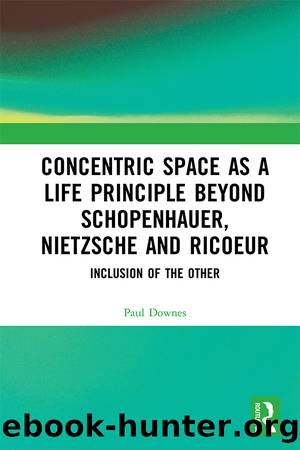Concentric Space As a Life Principle Beyond Schopenhauer, Nietzsche and Ricoeur by Paul Downes;

Author:Paul Downes;
Language: eng
Format: epub
Publisher: Taylor & Francis (CAM)
Published: 2020-07-15T00:00:00+00:00
As a compensatory atonement, the goat is in a diametric mirror image relation to the god and mask as god manifestation. In contrast, concentric space offers no such recompense; it is not within the borders of a compensatory reversal such as that of the diametric space of inversion. The function of atonement, of a kind of debtor–creditor relationship, is one of a diametric mirror image inversion. Otherness as substitute is within the diametric structure of sacrifice for atonement. This is scarcely a structure of inclusion of the other.
Ivanov remarks on the ‘many contrary principles that are reconciled in Dionysian religion, solemn weeping and unbridled laughter, sacrifice and dance, the ivy of winter and the rose of spring’ (quoted and translated in West 1970: 78). Much depends on the conception of reconciliation. A diametric spatial mirror image symmetry holds contrary principles together in a common structured relation, yet this is far from an active reconciliation, but is more a dynamic tension. Such oppositional tension gives expression to a figure–ground relation as a variant of diametric space. However, these relations do not offer a structural reconciliation but rather hold both domains separately in a diametric space of assumed separation without mutual transformation; there is no restructuring of mutual boundaries to bring an assumed connection of concentric space.
Dionysus as a life-bearing principle is, in Kerenyi’s words, turned to death through the sacrificial rites. Again this is a diametric mirror image reversal. Moreover, Kerenyi refers to the ‘subterranean Dionysus’ (1976: 289) as a reversal of life itself. The dual aspect of Dionysus, recognised explicitly by Kerenyi, is that of protector of life and killer of life in death. Kerenyi described this ritual realisation in Dionysian festivals: ‘The murder of the Divine Child was his reduction to an organ from which – or as which – he could be reawakened’ (1976: 267). This led to ‘phallus processions and merry Dionysian festivals … held throughout the Greek countryside’ for the Dionysus of the Athenians (1976: 285), ‘the protector of life’, ‘the lord of all living creatures’ (1976: 323). These ritual sacrifices betray a clear diametric mirror image inversion structure – including a shift from passive receipt of the death of the child Dionysus to active perpetration of death of a sacrificial animal or child in the Dionysian rites. The community exerts a power over the suffering, even through its diametric structured mirror image ambivalence of concern and aggression towards the sacrificial animal, whether he-goat, bull or indeed child.
The will to power, as with the dual-sidedness of the Dionysian cults and myths, accommodates a life principle within a wider principle of power to negate this principle, in an overall diametric spatial projection of inverted symmetry. The diametric spatial projection of inversion through Dionysian atonement is the shift from passive suffering to active infliction of suffering and killing as part of the will to power. The will to power subsumes the will to life as an element within its wider systemic propagation.
While Kerenyi also supports the view of
Download
This site does not store any files on its server. We only index and link to content provided by other sites. Please contact the content providers to delete copyright contents if any and email us, we'll remove relevant links or contents immediately.
Should I Stay or Should I Go? by Ramani Durvasula(6784)
Why We Sleep: Unlocking the Power of Sleep and Dreams by Matthew Walker(5640)
Fear by Osho(4085)
Flow by Mihaly Csikszentmihalyi(4051)
Rising Strong by Brene Brown(3780)
Why We Sleep by Matthew Walker(3771)
Too Much and Not the Mood by Durga Chew-Bose(3693)
How to Change Your Mind by Michael Pollan(3673)
The Hacking of the American Mind by Robert H. Lustig(3579)
Lost Connections by Johann Hari(3454)
He's Just Not That Into You by Greg Behrendt & Liz Tuccillo(3300)
Evolve Your Brain by Joe Dispenza(3050)
What If This Were Enough? by Heather Havrilesky(2945)
Resisting Happiness by Matthew Kelly(2886)
Crazy Is My Superpower by A.J. Mendez Brooks(2858)
The Courage to Be Disliked by Ichiro Kishimi & Fumitake Koga(2795)
The Book of Human Emotions by Tiffany Watt Smith(2770)
Descartes' Error by Antonio Damasio(2731)
In Cold Blood by Truman Capote(2684)
